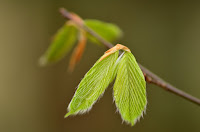What: So in response to Ryan's comment about sugar maples being considerably later than their breathren to leaf out I set out to document some of the later-to-burst buds. A loose pattern I thought I found was that the later species to bud out seem to be the ones that are more shade tolerant. But my sample is too small to make anything other than a very gross generalization (and probably not that correct). I also didn't notice whether or not there's a difference between individuals in the canopy and individuals in the understory. I couldn't find great data on the order of when species leaf out (Project Bud Bursts data set isn't that great) so looks like I'll have to keep investigating.
I know that there is variation within a population due to small-scale climatic features. In the posting on dandelions I described finding dandelions that had gone to seed earliest in south-facing spots adjacent to buildings or rocks. Trees in similar warm areas tend to leaf out earlier. I followed up on the shade-tolerance piece and didn't find a whole lot pertinent to leafing out. It is pretty well established that a woody species' shade tolerance is most relevant in the seedling/sapling stages. The following table is condensed from Humbert et al.'s 2007 paper "A shade tolerance index for common understory species of northeastern North America". It gives ranks each species from 1-9, with 9 being the least tolerant of shade and 1 being the best, an X means that it has a wide range of tolerances. The real table has more trees, lots of herbaceous plants and even some mosses and liverworts.
Latin name
|
Common name
|
Shade tolerance index
|
Abies balsamea
|
Balsam fir
|
3
|
Acer pensylvanicum
|
Striped
maple
|
3
|
Acer rubrum
|
Red maple
|
5
|
Acer saccharum
|
Sugar maple
|
4
|
Acer spicatum
|
Mtn maple
|
5
|
Alnus incana ssp.
rugosa
|
Speckled
alder
|
7
|
Betula alleghaniensis
|
Yellow birch
|
5
|
Betula papyrifera
|
White birch
|
7
|
Comptonia peregrina
|
Sweet fern
|
7
|
Cornus alternifolia
|
Alt leaf
dogwood
|
4
|
Cornus canadensis
|
Bunchberry
|
X
|
Corylus cornuta
|
Witch hazel
|
4
|
Fagus grandifolia
|
American beech
|
2
|
Fraxinus nigra
|
Black ash
|
5
|
Larix laricina
|
Tamarack
|
9
|
Ledum groenlandicum
|
Bog Labrador tea
|
7
|
Lonicera canadensis
|
Fly honeysuckle
|
X
|
Myrica gale
|
Sweetgale
|
8
|
Ostrya virginiana
|
Hophornbeam
|
X
|
Picea glauca
|
White spruce
|
4
|
Picea mariana
|
Black spruce
|
X
|
Pinus resinosa
|
Red pine
|
8
|
Pinus strobus
|
White pine
|
6
|
Populus balsamifera
|
Balsam
poplar
|
9
|
Populus grandidentata
|
Big-tooth aspen
|
9
|
Populus tremuloides
|
Quaking
aspen
|
9
|
Prunus pensylvanica
|
Pin cherry
|
9
|
Prunus serotina
|
Black
cherry
|
8
|
Prunus virginiana
|
Chokecherry
|
X
|
Quercus rubra
|
Red oak
|
7
|
Salix discolor
| American willow | 8 |
| Salix humilis |
Prairie willow
|
9
|
Sambucus racemosa
|
Red elderberry
|
5
|
Taxus canadensis
|
Canada yew
|
2
|
Thuja occidentalis
|
White cedar
|
3
|
Tsuga canadensis
|
Hemlock
|
3
|
Ulmus americana
|
Elm
|
6
|
Vaccinium
angustifolium
|
Lowbush blueberry
|
7
|
The other columns that I would like to see in here would be simple vs compound leaf, ring-porous vs diffuse porous, successionary stage, and dry vs wet habitat preference, freezing killing temperature, herbivore pressure, leaf drop date, flowering date, furthest north latitude, center of evolutionary group's range, among others. So it's a start, but for now mostly just pretty pictures and a cool table.






.JPG)
No comments:
Post a Comment